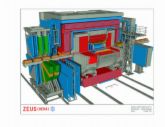Physics with ZEUS @
HERA
The very high energies offered by HERA in e�p interactions permit one to probe deep inside the proton in order to study the structure of its constituents, the quarks and gluons. According to Uncertainty principle a measure for the smallest size D of resolved objects is the transverse momentum kick Q which the electron impacts to the proton, D ~ h/Q with Q2 values as high as 40000 GeV2 can be reached at HERA corresponding to D = 10-16 cm which is a factor 1000 smaller than the proton radius. With this resolving power exciting physics topics can be studied, such as substructure of quarks and electrons, neutral and charged current processes, tests of Quantum Chromo-dynamics, searches for new currents and for new particles. The success of such studies depends critically on the accuracy with which the energies and angles of the particles and particle bundles called jets resulting from the interactions can be measured.
 Zeus Detector
Zeus Detector

Electron - proton
scattering
Group
Members
Currently following EHEP group members are participating in
this ZEUS experiment at HERA since
January 2007;
- Dr. Manjit Kaur Professor (email: manjitATpu.ac.in)
- Mr. Inderpal Singh Senior Research Fellow
- Ms. Prabhdip Kaur Senior Research Fellow
Physics Analysis
The group is involved in the
;
(i) Measurement of longitudinal
Structure function FL
(ii) Measurement of �neutral current cross-sections
The work is being pursued in
collaboration with ZEUS team from Max Planck Institute of Physics and
Astrophysics at
The participation is made possible by generous
grants from Max Planck Institute,
Links
http://www.zeus.com/